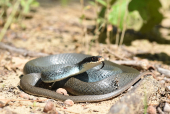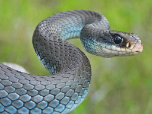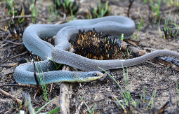Blue Racer (Coluber constrictor foxii)
Description: Blue racers often have creamy white ventral scales, dull grey to brilliant blue lateral scales, and pale brown to dark grey dorsum. They also have characteristic black masks, relatively large eyes, and often have brownish-orange rostral scales (snouts). Unlike adults, hatchlings and yearlings (first full active season) have dorsal blotches that fade completely by the third year; however, juvenile patterning is still visible on the venter until late in the snake's third season.
Habitat: Blue racers prefer open and semi-open habitats, savanna, old field shoreline, and edge habitats. A mosaic of these habitats is likely required to fulfill the ecological needs of C. c. foxii.
Range: In the United States: Ohio, Indiana, Illinois, Michigan, Wisconsin, and Iowa are now the only states with extant populations of blue racer. The last reliable record of the blue racer on mainland Canada was in Ontario in 1983. On Pelee Island in Ontario, the blue racer is restricted to the eastern two-thirds of the island.
Diet: Blue racers are active foragers. The younger snakes may consume crickets and other insects, whereas adults feed primarily on rodents, songbirds and other snakes. Adults engage in both terrestrial and arboreal foraging.
Reproduction: The blue racer is oviparous and the average clutch size for seven females is 14.7 ± 2.53. Females can reproduce annually, but biennial cycles are likely more common. Males can mature physiologically at 11 months, but do not have the opportunity to mate until their second full year; similarly, females may mature at 24 months but are not able to reproduce until the following year. Mating begins in April and continues throughout May. Females oviposit in late June and eggs hatch from mid-August to late-September. The most common nesting microhabitats used by female blue racers are fallen decaying logs; however, eggs are also laid under large rocks and in mounds of decaying organic matter. Intra- and interspecific (with the eastern fox snake) communal nest sites have been documented and appear to be relatively common.
Status: The snake has not yet been assessed for the IUCN Red List in terms of conservation, but is listed as endangered in Canada by the Committee on the Status of Endangered Wildlife in Canada. It is listed as a species of special concern in the state of Wisconsin.
»» Kingdom: Animalia - Animals
»» Phylum: Chordata - Chordates
»» Subphylum: Vertebrata - Vertebrates
»» Class: Reptilia - Reptiles
»» Order: Squamata - Scaled Reptiles
»» Suborder: Serpentes
»» Superfamily: Colubroidea
»» Family: Colubridae - Colubrids
»» Genus: Coluber
»» Species: Coluber constrictor - North American Racer
»» Subspecies: Coluber constrictor foxii - Blue Racer
This article uses material from the Wikipedia article "Coluber constrictor foxii", which is released under the Creative Commons Attribution-Share-Alike License 3.0. Content may have been omitted from the original, but no content has been changed or extended.
|








